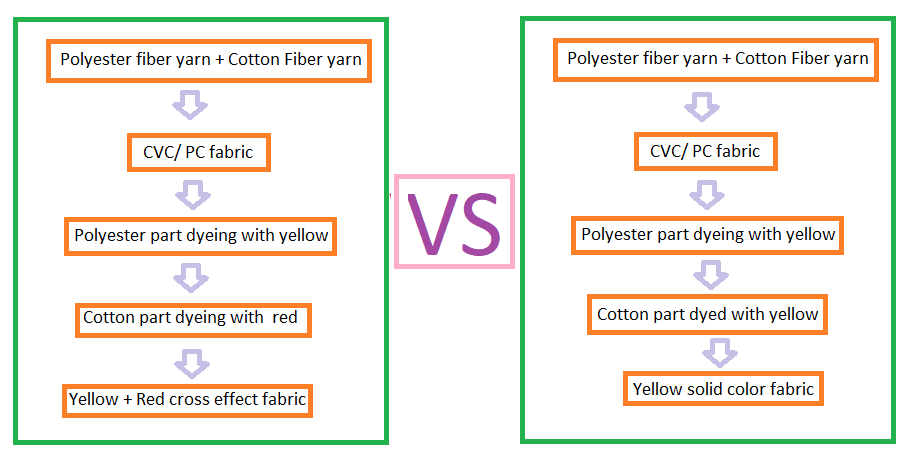Cross-dyeing and union dyeing are simply opposite of each other. These two dyeing processes are done on the fabric which consists of more than one fiber. In the basic, Cross dyeing has two different color effects in one fabric. On the other hand, union dyeing has only one color effect on the fabric. These two types carate a special effect on garment dying.
Cross dyeing:
Cross dyeing is a dyeing process in which two or more fibers are dyed with two different colors with different dyestuff in one fabric. It creates a special type of cross-melange effect on yarn, fabric, and even garments.
As an example:
A cross fabric made of =Polyester fiber yarn + Cotton fiber yarn
Then these two fibered fabrics will be dyed in one bath. The first polyester and then cotton will be done.
Polyester Dyeing= Dyed with dispersed dye yellow
Cotton dyeing = Dyed with reactive dye red
Finally, we get a Yellow+red cross melange= Cross dyed fabric
Union Dyeing:
Union dyeing is a dyeing process in which two or more fibers are dyed the same color with different dyestuff. It creates an even solid look on the fabric, yarn, and even garments.
As an example:
A union fabric made of =Polyester fiber yarn +Cotton fiber yarn
Then these two fibered fabrics will be dyed in one bath. The first polyester and then cotton dyeing will be done.
Polyester dyeing Dyed with dispersed dye yellow.
Cotton dyeing = Dyed the same shade of yellow with reactive dyes.
Finally, we get a solid yellow color= Union dyed fabric
The cross and unique dyeing mechanism image:

The basic difference between Cross dyeing and union dyeing:
| Cross dyeing | Union dyeing |
| Create Multi-color effect | Only one color effect |
| Different fiber is dyed with different color | Different fibers dyed with the same color |
| Easy to create effect during the dyeing | Difficult to match fibers with each other |
| We can get multi-patterned fabric(Using different colors and different fibers) | Only one patterned fabric |
Why do we need cross and union dyeing?
Cross-dyeing and union dyeing are carried out for various reasons, primarily to address challenges associated with fabrics made from a combination of different fibers. Here are some key reasons for performing cross-dyeing and union dyeing:
- Fabric Composition:
- Cross Dyeing: When a fabric is composed of a blend of fibers with different dye affinities, cross-dyeing allows for the application of multiple dyes to achieve distinct colors on each fiber type. This is common in fabrics with a mix of natural fibers (like cotton) and synthetic fibers (like polyester).
- Union Dyeing: If the fabric is made from a blend of fibers that can be dyed with the same type of dye, union dyeing ensures a uniform and consistent color across the entire fabric. This is often the case when working with fibers that have similar dyeing properties, such as different types of cellulosic fibers.
- Aesthetic Appeal:
- Cross Dyeing: It is used to create visually interesting and dynamic patterns on the fabric by exploiting the unique dyeing characteristics of each fiber. This can result in a multi-colored or variegated appearance, enhancing the aesthetic appeal of the fabric.
- Union Dyeing: For fabrics where a uniform color is desired, such as in solid-colored garments or home textiles, union dyeing ensures that all fibers in the blend take on the same color. This provides a cohesive and consistent look.
- Color Effects:
- Cross Dyeing: Offers the opportunity to achieve color contrast or complementary effects by applying different colors to fibers with different dye affinities. This is particularly useful for creating intricate and customized designs.
- Union Dyeing: This enables the creation of fabrics with a single, uniform color throughout, which is ideal for a clean and consistent appearance.
- Dye Compatibility:
- Cross Dyeing: When the fibers in a fabric are not compatible with the same type of dye, cross dyeing allows for the use of multiple dyes that are suitable for each specific fiber type.
- Union Dyeing: Applied when the fibers in the fabric share dye compatibility, allowing for the use of a single type of dye that can uniformly color all the different fibers.
In summary, both cross-dyeing and union dyeing are strategic approaches in textile dyeing, addressing the challenges posed by mixed fiber compositions and contributing to the versatility and aesthetic possibilities of the final products. The choice between the two techniques depends on the specific characteristics of the fabric and the desired visual outcome.
Final word:
I think this article will create a crear wise photograph in your mind about cross and union dyeing and the image I provided will clear you about hole the matter
You may read some other articles:
[…] What Is Cross And Union Dyeing? Basic Difference Between Them […]
[…] What Is Cross And Union Dyeing? Basic Difference Between Them […]